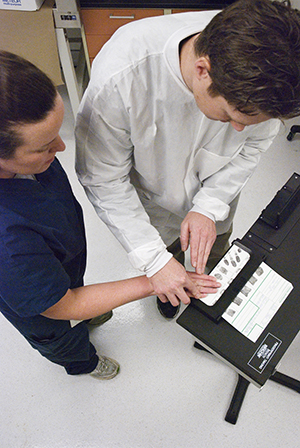Fingerprints
 Fingerprints offer a powerful means of personal identification and still remain the most commonly used forensic evidence worldwide.
Fingerprints offer a powerful means of personal identification and still remain the most commonly used forensic evidence worldwide.
Fingerprint Laboratory:
Fingerprints are unique and persistent; because of this, fingerprints are an excellent means of identification.Forensic Scientists within the Fingerprint Laboratory:
- Develop and recover latent prints from evidence
- Analyze any latent impressions that are detected
- Compare these impressions with the known prints of individuals
- Search them through the automated database.
An additional service provided by the Fingerprint Lab is the identification of deceased individuals. Fingerprints may be recorded from deceased individuals which can be compared to known exemplars of individuals in order to identify the decedent.
Fingerprint Methodologies:
 Development techniques routinely utilized by the Fingerprint Lab include:
Development techniques routinely utilized by the Fingerprint Lab include:
- Visual Examination
- Alternated Light Source Examinations (used to visualize fluorescent techniques or inherent luminescence)
- Cyanoacrylate Fuming (superglue fuming which adheres to moisture in latent print residue on non-porous surfaces)
- Cyanoacrylate Dye Stains (fluorescent dye stain used after cyanoacrylate fuming)
- Powders (adheres oils, moisture and contaminants in latent print residue)
- Ninhydrin (reacts with amino acids present in sweat, used on porous surfaces)
- DFO (reacts with amino acids present in sweat producing a fluorescent reaction, used on porous surfaces)
- 1,2-Indanedione (reacts with amino acids present in sweat producing a fluorescent reaction, used on porous surfaces)
- Physical Developer (reacts with non-soluble components of latent print residue, can be used to process porous items exposed to moisture)
- Amido Black (protein enhancer for blood prints)
 Small Particle Reagents (powder suspension that can be used to process non-porous items exposed to moisture)
Small Particle Reagents (powder suspension that can be used to process non-porous items exposed to moisture)- Adhesive Processing Techniques (powder suspensions such as wet powder and dial soap formulations that can be used to develop latent prints on adhesive surfaces)
- Latent print examinations are conducted utilizing the ACE-V methodology. This is a sequential process which consists of four phases; Analysis, Comparison, Evaluation and when appropriate, Verification.
- Analysis—the assessment of an impression to determine suitability for comparison
- Comparison—the observation of two or more impressions to determine the existence of discrepancies, dissimilarities or similarities
- Evaluation—decision making step in which an examiner reaches a conclusion based upon the information observed in Analysis and Comparison
- Verification—a second latent print examiner will conduct an independent ACE examination of the latent print to either support or refute the conclusion of the first examiner.
Links:
- International Association for Identification
- Organization of Scientific Area Committees (OSAC) Friction Ridge Subcommittee
- Scientific Working Group on Friction Ridge Analysis, Study and Technology
How could we make it better? Leaving an email can assist us in troubleshooting the issue.
Thank you for your feedback
Your feedback means a lot to us. We use it to improve the experience of all of our users.
 An official website of the Cuyahoga County government. Here’s how you know
An official website of the Cuyahoga County government. Here’s how you know


